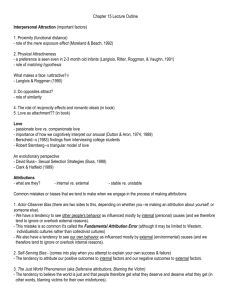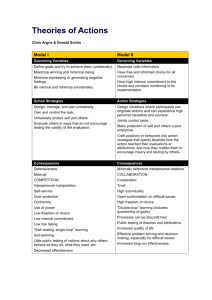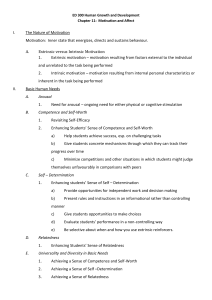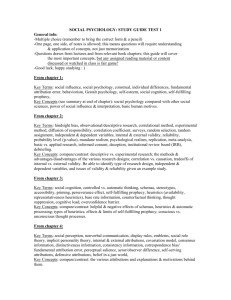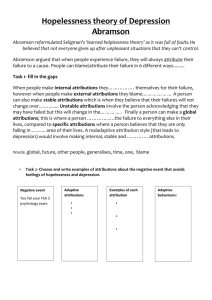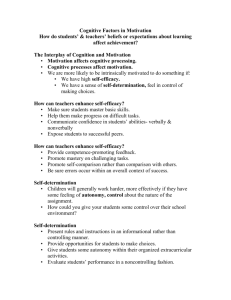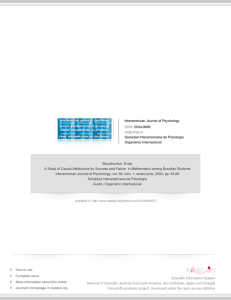Measuring Stress & Coping
advertisement
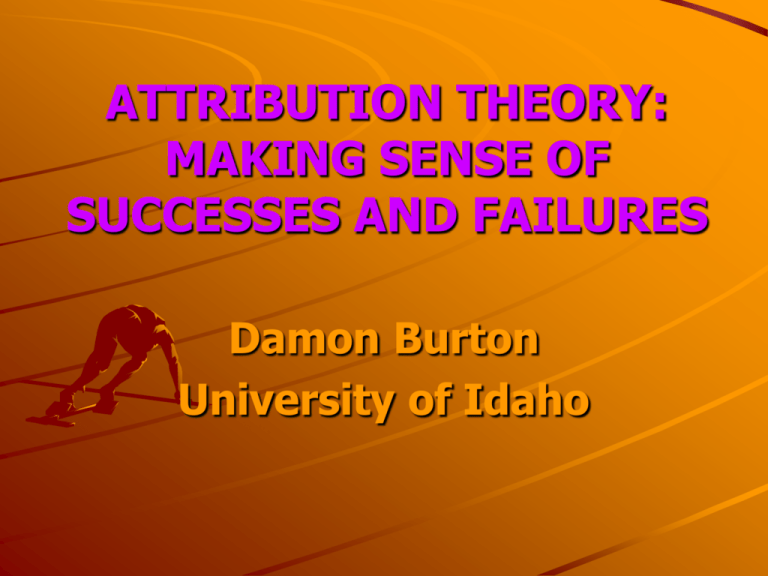
ATTRIBUTION THEORY: MAKING SENSE OF SUCCESSES AND FAILURES Damon Burton University of Idaho WHAT IS AN ATTRIBUTION? Attributions – are reasons given to explain successes and failures. Weiner (1985) suggests that we each act as naïve psychologists trying to understand the reasons for why a particular outcome occurs. For example, a girl may try to figure out why she lost a tennis match or did poorly on an exam. UNDERLYING ASSUMPTIONS Understanding human behavior requires first understanding how we perceive the social environment. People seek a stable and predictable environment in order to control their surroundings and predict others’ behavior. To understand behavior, people look for dispositional qualities in others. ATTRIBUTIONAL PROPOSITIONS Outcomes generate positive or negative emotions and a search for the reasons for the outcome. Attributions are organized into key dimensions that influence psychological consequences such as expectancy change or emotional feelings. Attributional consequences impact behaviors such as achievement motivation. WEINER’S (1972) ORIGINAL MODEL Internal Stable Ability Effort Unstable Strategy Preparation Performance External Task Difficulty Coaching Luck Officiating WEINER’S (1986) REVISED MODEL CAUSAL ANTECEDENTS OF ATTRIBUTIONS states versus traits causal rules “actor versus observer bias” “hedonic bias” ASSESSING ATTRIBUTIONS • A person’s perceptions of success and failure are not the same as winning and losing. Success is a subjective concept. • Most attributions have been categorized by researchers rather than participants. • Weiner uses dimensions of locus of causality, stability and controllability • Globality and intentionality dimensions have also been proposed ATTRIBUTION INSTRUMENTS • Causal Dimension Scale – 2 (CDS-2) – • measures attributions in specific situations (state measure). Attributional style is predisposition to make particular attributions across different situations (trait measure) • Sport Attributional Style Scale (SASS) • Wingate Sport Achievement Responsibility Scale (WSARS) SELF-SERVING BIAS “Self-serving bias” (SSB) states that attributions are used to enhance and protect self-esteem. According to the SSB, people tend to take credit for success but not the blame for failure. People perceive themselves as more responsible for successful or positive than negative outcomes. Reasons for failure are externalized (i.e., blamed on outside factors) ACTOR-OBSERVER BIAS “Actor-observer bias” –actors and observers view the same situation differently, thus making different attributions Actors use situation-based attributions to explain their behavior. Observers base attributions on traits of the actor. Actors know their behavioral history, whereas observers have only the one situation to base their evaluation on. SPONTANEOUS ATTRIBUTIONS Do athletes normally engage in causal thought (i.e., attributions) following competition? Attributions are made naturally, but they are more likely when (a) a goal is not attained or (b) the outcome was unexpected. For example, the Patriots probably have been making attributions for their unexpected Superbowl loss. ATTRIBUTIONAL CONSEQUENCES future expectancies emotional reactions learned helplessness FUTURE EXPECTANCIES Attributional stability is the most important factor determining future expectancies. Outcomes ascribed to stable causes increase future expectancy. Outcomes ascribed to unstable causes reduce future expectancy Outcomes ascribed to stable causes will be repeated more frequently than those ascribed to unstable causes EMOTIONAL REACTIONS “Outcome-dependent” emotions are emotional responses to the outcome itself, whereas “attributiondependent” emotions relate to the causes or reasons identified for the outcome. “Self-esteem emotions” such as pride are associated with internal causality. “Expectancy emotions” such as hope are related to stability. “Social emotions” such as pity or guilt are related to controllability. The End

